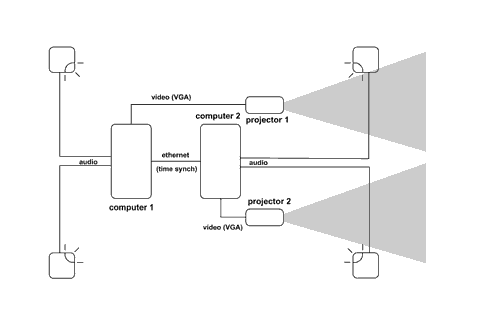Ian Andrews
Generative
In a Few Seconds Across the Ocean (2004)
The emulation has some problems. Some of the text is rendered as abstract shapes and the sound is a bit different from the original.
A multichannel generative audio/visual/textual collage for the wireless imagination

In 1909 Marconi was awarded the Nobel Prize for physics on account of his work with wireless telegraphy. News could be transmitted and received virtually instantaneously thousands of miles away, and so the distance negating power of radio fed a desire to attribute mystical qualities to it. A plethora of poetic texts appeared right across Europe, bearing the influence of this new science. The German Expressionist, Franz Richard Behrens wrote in a style which he called Telegrammstil; Ukrainian Panfuturist Mykalo Semenko wrote "Cable Poem of the Ocean"; Mayakovsky, in 1914 declared that the nervous life of cities requires quick economical abrupt words; Blaise Cendras experimented with a form he called the "telegramme poem;" Nicolas Beauduin was writing wireless poems and the Polish Futurist Stanilaw Mlodozenieg wrote telegraphic poems. Radio and wireless telegraphy is also mystified and fetishised in a number of Italian Futurist texts: Marinetti’s Zang Tumb Tumb (1914), Fillia’s Lussuria Radio Elettica (1925), Gerbino’s Telegrapho e Telephono dell Anima (1926), Emilo Buccafusca’s Realradioculla (1934), Farfa’s Marconia (1937), Buzzi’s Poema di Radio-onde (1940), Marinetti and Masnata’s La Radia (1933), and Depero’s Uriche-radiofoniche (1934). Technology, particularly wireless communication, became an aesthetically determining factor, in both poetic form and content. The Italian and the Russian Futurists were concerned with the liberation of language from convention meaning in order to be able to express, at the speed of pure thought, the ubiquity of Being in a fast and multifarious world.
In a Few Seconds Across the Ocean refers to, and interrogates a number of references from 20th century art that might broadly be described as “a poetics of radio (and noise)” ranging from the Futurist poetry of Marinetti, Klebnikov to Karlheinz Stockhausen’s 1966 work Hymnen: anthems for electronic and concrete sounds (which provides the source of the title). The work utilises a number of generative techniques (random number generation, permutative structures, and graphics/sound interaction) to produce aleatory music graphics and text. The piece plays continuously in a loop that never repeats in the same way twice. The generative structure is designed to create a multi-channel sound environment where the randomisation of the process distributes the different sound elements throughout the space.
I see this work as both part of, and a response to recent work (music, sound art and net art) which has been broadly described as post-digital. In one sense, post-digital refers to works that reject the hype of the so-called digital revolution. The familiar digital tropes of purity, pristine sound and images and perfect copies are abandoned in favour of errors, glitches and artefacts. And in another sense (as in the term post-modernism) it refers to the continuation or completion of that trajectory. Post-digital music incudes a number of sub-genres: glitch, clicks & cuts, microsound, headphonics, etc. All are, more or less, concerned with the foregrounding of the flaws inherent in digital processes. This valorisation of what previously would have been seen as noise: a by-product, bearing an external relation to the work, would be one of the characterising marks of a post-digital aesthetic. An aesthetic made up of minuscule stabs of sound, clicks, glitches, buzzes, light airy drones and hisses, mangled ring-modulated tones and grainy clouds of noise/pixels.
On the other hand, this work attempts to go beyond the uncritical (re)production of modernist themes and aesthetics (singularity, purity, form over content) which have become all to common in this area of artistic practice. Instead it seeks to interrogate modernist aesthetics from a standpoint which is hybrid, fragmented, culturally dispersed and informed by post-modern (inter)textuality.
In particular it attempts to displace the idealist opposition of divine, or natural writing (‘Words in Freedom’), over human finite inscription, which characterises many of the Constructivist and Futurist texts, shifting the idea of “poetic language,’ instead, towards noise and difference.